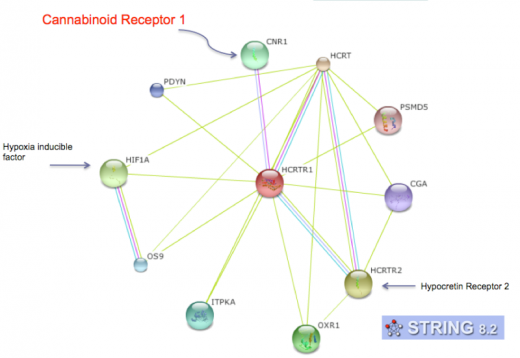This web page was produced as an assignment for Genetics 677, an undergraduate course at UW-Madison
Protein Interactions
Proteins interact with other proteins on various levels: long-range, short-range, directly, indirectly, and many other ways. These interactions are responsible for all biological functions. Therefore, the knowledge of these interactions and pathways are extremely important if one is interested in the understanding the functions of a protein. The study of protein-protein interactions is known as proteomics. There are a few website databases that are concerned with protein-protein interactions. STRING is one of the online databases that conducts a search for known and predicted protein interactions for a protein of interest. It searches for interaction information from primary literature, genomic context, and high throughput experiments.
Using STRING, I searched for proteins that do (or are predicted to) interact with the hypocretin receptor 1. The results are depicted in the interactome map below:
Using STRING, I searched for proteins that do (or are predicted to) interact with the hypocretin receptor 1. The results are depicted in the interactome map below:
Figure 1: Hypocretin Receptor 1 interactome map; courtesy of STRING website. Clicking on the image will give a larger image which is easier to read. Arrows indicate the proteins discussed below.
Analysis
The hypocretin (orexin) receptor 1 is a member of the guanine-nucleotide-binding proteins, known as G-proteins. Therefore while looking for functional partners of the hypocretin receptor 1, it makes sense that the proteins STRING turned up would be in a related family. Most of the proteins that do (are predicted to) interact with the hypocretin receptor 1 are other receptors. The hypocretin protein (HCRT) is one protein I expected to be on this map, as it is the protein that binds to the hypocretin receptor 1. Another familiar protein was hcrtr2 which is the other hypocretin receptor protein. This protein can bind hypocretin 1 and 2, and interacts with hcrtr1.
One functional partner that I thought was interesting was the cnr1 protein, which is one of two cannabanoid receptors. I will go into more detail about this receptor protein in the conclusion page.
Another protein that I thought was interesting was hypoxia-inducible factor 1 alpha (HIF1A). This protein is the master transcriptional regulator of the adaptive response to hypoxia conditions. Because this protein is very influential in mediating body functions including metabolism, I thought it would be an interesting protein to look into in having a possible implication in narcolepsy.
The Osprey program is another protein-protein search program. However, the results had the same information as STRING, only less so I did not include it.
One functional partner that I thought was interesting was the cnr1 protein, which is one of two cannabanoid receptors. I will go into more detail about this receptor protein in the conclusion page.
Another protein that I thought was interesting was hypoxia-inducible factor 1 alpha (HIF1A). This protein is the master transcriptional regulator of the adaptive response to hypoxia conditions. Because this protein is very influential in mediating body functions including metabolism, I thought it would be an interesting protein to look into in having a possible implication in narcolepsy.
The Osprey program is another protein-protein search program. However, the results had the same information as STRING, only less so I did not include it.
References:
(1) STRING online protein-protein interaction database.
Eric Suchy, Email: [email protected], last updated: May 15, 2010

